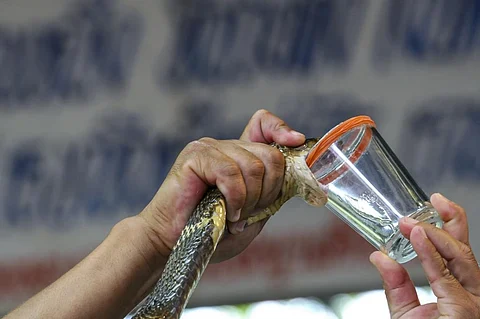

Researchers from the Serum Institute of India (SII), Pune and the Indian Institute of Science (IISc), Bengaluru, have shown that purifying commercial antivenoms available in Indian markets can make them more potent and thus save more lives of snakebite victims.
This is significant as India is home to over 300 species of snakes. Of these, only around 60 described snake species are capable of causing harm to humans. But, over 58,000 people die in India every year and three times the number suffer permanent disabilities due to snakebites, according to a study by IISc published last year.
Read:
On June 9, 2017, the World Health Organization (WHO) included snakebite into the list of ‘Neglected Tropical Diseases’ — a diverse group of tropical infections affecting poor communities in Africa, Asia and the Americas.
The study conducted by the SII and IISc scientists was published February 24, 2022. It was titled The Preclinical Evaluation of a Second-Generation Antivenom for Treating Snake Envenoming in India.
There are a number of problems with the antivenoms available currently in the Indian market.
Kartik Sunagar, assistant professor and Wellcome Trust DBT India Alliance Fellow at the Centre for Ecological Sciences, IISc and senior author of the study, told Down To Earth:
The current antivenoms are very ineffective. You require a lot of vials of antivenom for treating snakebites. They are also not pure. One can suffer from a lot of other conditions such as serum sickness or fatal anaphylaxis, meaning the patient can die if the antivenom is administered in large amounts.
There is also another problem.
The existing Indian antivenoms are produced exclusively against the so-called ‘big four’ Indian snakes: the spectacled cobra (Naja naja), common krait (Bungarus caeruleus), Russell’s viper (Daboia russelii) and saw-scaled viper (Echis carinatus).
“The inefficaciousness of Indian antivenoms stems from the geographically restricted sources of venoms used in the antivenom manufacturing process. The immunisation mixture used in this process consists of venoms sourced from the ‘big four’ snakes in the southernmost part of the country and the resultant product is used for snakebite treatment across India,” the study noted.
“Therefore, this polyvalent antivenom fails to counter the tremendous intra- and interspecific venom variations documented in medically important Indian snakes,” it added.
What was done?
The SII purified antivenoms at the production stage. “The impurities were removed from conventionally marketed products through a purification process known as chromatographic purification,” Sunagar told DTE. The antivenom produced was thus a second-generation one.
He and the rest of the scientists from SII and IISc also procured all major antivenoms available in the market and compared the effectiveness of these as well as the second generation antivenom through a mouse model.
“Antivenoms being sold in the market claim they can neutralise 0.6 milligrams (mg) of Cobra or Russell’s viper venom per millilitre (ml) of antivenom. Or that they can neutralise 0.45 mg of echis or bungarus venom per ml of antivenom,” Sunagar said.
“That is the marketed potency. But if you look at our research findings so far, the actual performance of antivenoms is much lower than this,” he added.
Sunagar said: “If you assume that the marketed products exhibit the marketed values, then the new second-generation antivenom that we have made exhibits up to 4.6 times better neutralisation potential.”
What this means is one would now require very less amounts of antivenoms for treating snakebite victims and the samples would be much purer, thus eliminating their secondary side effects.
“We have now shown that you can use these strategies to improve the existing antivenoms without the need for reinventing the wheel,” Sunagar said.
This is important since it will still be a decade at least till recombinant antivenoms are commonplace.
“Recombinant antivenoms are made in laboratory culture plates using genetic engineering. They are still being developed and researched by scientists around the world, including us in India. They will take a while to be available to snakebite victims and are at least a decade as they have to clear clinical trials,” Sunagar noted.
These antivenoms would be very specific and clean and one would not have to immunise animals to produce them.
“Recombinant antivenoms will result in an effective treatment of snakebite. As these antibodies can be engineered to become more ‘human antibody-like’, they will eliminate the secondary effects of conventional antivenoms. But it will take time to manufacture them commercially,” Sunagar said.